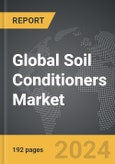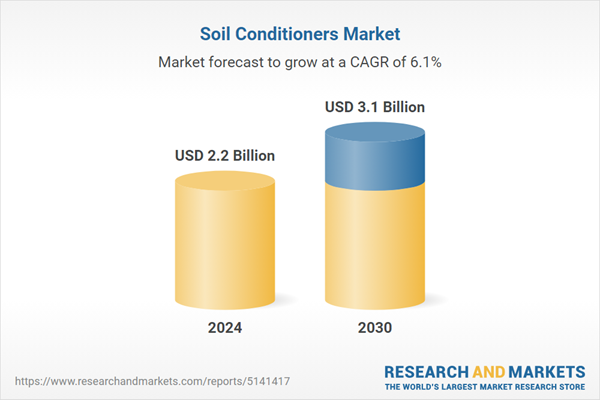The global market for Soil Conditioners was valued at US$2.2 Billion in 2024 and is projected to reach US$3.1 Billion by 2030, growing at a CAGR of 6.1% from 2024 to 2030. This comprehensive report provides an in-depth analysis of market trends, drivers, and forecasts, helping you make informed business decisions. The report includes the most recent global tariff developments and how they impact the Soil Conditioners market.
Segments: Soil Type (Loam, Sand, Clay, Silt, Peat); Crop Type (Cereals & Grains, Oilseeds & Pulses, Fruits & Vegetables, Other Crop Types); Application (Agriculture, Industrial, Other Applications).
Geographic Regions/Countries: World; United States; Canada; Japan; China; Europe (France; Germany; Italy; United Kingdom; Spain; Russia; and Rest of Europe); Asia-Pacific (Australia; India; South Korea; and Rest of Asia-Pacific); Latin America (Argentina; Brazil; Mexico; and Rest of Latin America); Middle East (Iran; Israel; Saudi Arabia; United Arab Emirates; and Rest of Middle East); and Africa.
The analysts continuously track trade developments worldwide, drawing insights from leading global economists and over 200 industry and policy institutions, including think tanks, trade organizations, and national economic advisory bodies. This intelligence is integrated into forecasting models to provide timely, data-driven analysis of emerging risks and opportunities.
Global Soil Conditioners Market - Key Trends and Drivers Summarized
Why Are Soil Conditioners Becoming Essential in Modern Agriculture?
Soil conditioners are increasingly recognized as crucial inputs in modern agriculture due to their ability to enhance soil structure, fertility, and water retention capabilities. As agricultural lands around the world face challenges such as soil erosion, compaction, and nutrient depletion, soil conditioners offer a solution by improving soil health and boosting crop yields. These materials, which can be organic or inorganic, help in breaking down compacted soil, increasing aeration, and promoting root growth. Organic soil conditioners, such as compost, manure, and biochar, not only enhance soil structure but also add essential nutrients, making them particularly popular among organic and sustainable farming practices. With the rising focus on sustainable agriculture, the adoption of soil conditioners is growing, especially in regions with deteriorating soil quality and intensive farming activities.How Are Technological Innovations Transforming the Soil Conditioners Market?
Technological advancements are significantly transforming the soil conditioners market, enabling the development of more effective and specialized products. Innovations in biotechnology and materials science have led to the creation of soil conditioners that are more efficient in enhancing soil health and fertility. Bio-based and polymer-based soil conditioners, for example, offer longer-lasting effects on soil structure and moisture retention compared to traditional products. The integration of soil conditioners with precision agriculture technologies, such as soil health monitoring systems and remote sensing, allows farmers to apply conditioners more efficiently based on real-time soil data. These advancements are driving the market forward, enabling more targeted and sustainable use of soil conditioners in both small-scale and large-scale farming operations.Which Market Segments Are Leading the Growth of the Soil Conditioners Industry?
Types of soil conditioners include organic and inorganic, with organic soil conditioners holding the largest market share due to their growing popularity in sustainable and organic farming. Soil types that benefit from soil conditioners include clay, sand, silt, loam, and peat, with clay and sandy soils being the most common due to their need for improved structure and water retention. Crop types span cereals and grains, fruits and vegetables, oilseeds, and others, with cereals and grains leading the market due to their widespread cultivation and high nutrient requirements. Applications of soil conditioners are categorized into agricultural, industrial, and residential, with agriculture dominating the market due to the high demand for soil enhancement in farming. Geographically, North America and Europe are the largest markets for soil conditioners, driven by strong agricultural sectors and a growing focus on sustainable farming practices, while Asia-Pacific is expected to witness significant growth due to increasing agricultural activities and soil degradation challenges.What Are the Key Drivers of Growth in the Soil Conditioners Market?
The growth in the soil conditioners market is driven by several factors, including the rising focus on sustainable agriculture, technological advancements in soil health management, and the increasing adoption of organic farming practices. The need to improve soil structure, fertility, and moisture retention is driving the demand for soil conditioners across various agricultural sectors. Technological innovations in bio-based and polymer-based soil conditioners are enhancing their effectiveness and expanding their application scope, supporting market growth. The integration of soil conditioners with precision agriculture technologies, such as soil sensors and remote sensing, is enabling more efficient and targeted application, creating new opportunities for market players. Additionally, the expansion of sustainable farming practices, government incentives for soil health improvement, and the increasing awareness about soil degradation and erosion are further propelling the growth of the soil conditioners market.Report Scope
The report analyzes the Soil Conditioners market, presented in terms of units. The analysis covers the key segments and geographic regions outlined below.Segments: Soil Type (Loam, Sand, Clay, Silt, Peat); Crop Type (Cereals & Grains, Oilseeds & Pulses, Fruits & Vegetables, Other Crop Types); Application (Agriculture, Industrial, Other Applications).
Geographic Regions/Countries: World; United States; Canada; Japan; China; Europe (France; Germany; Italy; United Kingdom; Spain; Russia; and Rest of Europe); Asia-Pacific (Australia; India; South Korea; and Rest of Asia-Pacific); Latin America (Argentina; Brazil; Mexico; and Rest of Latin America); Middle East (Iran; Israel; Saudi Arabia; United Arab Emirates; and Rest of Middle East); and Africa.
Key Insights:
- Market Growth: Understand the significant growth trajectory of the Loam segment, which is expected to reach US$1.6 Billion by 2030 with a CAGR of a 6.6%. The Sand segment is also set to grow at 6.7% CAGR over the analysis period.
- Regional Analysis: Gain insights into the U.S. market, valued at $563.5 Million in 2024, and China, forecasted to grow at an impressive 10.3% CAGR to reach $743.5 Million by 2030. Discover growth trends in other key regions, including Japan, Canada, Germany, and the Asia-Pacific.
Why You Should Buy This Report:
- Detailed Market Analysis: Access a thorough analysis of the Global Soil Conditioners Market, covering all major geographic regions and market segments.
- Competitive Insights: Get an overview of the competitive landscape, including the market presence of major players across different geographies.
- Future Trends and Drivers: Understand the key trends and drivers shaping the future of the Global Soil Conditioners Market.
- Actionable Insights: Benefit from actionable insights that can help you identify new revenue opportunities and make strategic business decisions.
Key Questions Answered:
- How is the Global Soil Conditioners Market expected to evolve by 2030?
- What are the main drivers and restraints affecting the market?
- Which market segments will grow the most over the forecast period?
- How will market shares for different regions and segments change by 2030?
- Who are the leading players in the market, and what are their prospects?
Report Features:
- Comprehensive Market Data: Independent analysis of annual sales and market forecasts in US$ Million from 2024 to 2030.
- In-Depth Regional Analysis: Detailed insights into key markets, including the U.S., China, Japan, Canada, Europe, Asia-Pacific, Latin America, Middle East, and Africa.
- Company Profiles: Coverage of players such as 420 Premium Markets Ltd., About The Garden Pty Ltd., Adeka Corporation, Agricultural Polymers International Ltd., Agrifert Nz Limited and more.
- Complimentary Updates: Receive free report updates for one year to keep you informed of the latest market developments.
Some of the 34 companies featured in this Soil Conditioners market report include:
- 420 Premium Markets Ltd.
- About The Garden Pty Ltd.
- Adeka Corporation
- Agricultural Polymers International Ltd.
- Agrifert Nz Limited
- Agromarketing Company, Inc.
- Agromin Corporation
- ASLE TECHNOLOGIES GROUP
- Betty's Azalea Ranch, Inc.
- Bio-Agronomics, Inc.
Tariff Impact Analysis: Key Insights for 2025
Global tariff negotiations across 180+ countries are reshaping supply chains, costs, and competitiveness. This report reflects the latest developments as of April 2025 and incorporates forward-looking insights into the market outlook.The analysts continuously track trade developments worldwide, drawing insights from leading global economists and over 200 industry and policy institutions, including think tanks, trade organizations, and national economic advisory bodies. This intelligence is integrated into forecasting models to provide timely, data-driven analysis of emerging risks and opportunities.
What’s Included in This Edition:
- Tariff-adjusted market forecasts by region and segment
- Analysis of cost and supply chain implications by sourcing and trade exposure
- Strategic insights into geographic shifts
Buyers receive a free July 2025 update with:
- Finalized tariff impacts and new trade agreement effects
- Updated projections reflecting global sourcing and cost shifts
- Expanded country-specific coverage across the industry
Table of Contents
I. METHODOLOGYII. EXECUTIVE SUMMARY2. FOCUS ON SELECT PLAYERSIII. MARKET ANALYSISCANADAITALYSPAINRUSSIAREST OF EUROPESOUTH KOREAREST OF ASIA-PACIFICARGENTINABRAZILMEXICOREST OF LATIN AMERICAIRANISRAELSAUDI ARABIAUNITED ARAB EMIRATESREST OF MIDDLE EASTIV. COMPETITION
1. MARKET OVERVIEW
3. MARKET TRENDS & DRIVERS
4. GLOBAL MARKET PERSPECTIVE
UNITED STATES
JAPAN
CHINA
EUROPE
FRANCE
GERMANY
UNITED KINGDOM
ASIA-PACIFIC
AUSTRALIA
INDIA
LATIN AMERICA
MIDDLE EAST
AFRICA
Companies Mentioned (Partial List)
A selection of companies mentioned in this report includes, but is not limited to:
- 420 Premium Markets Ltd.
- About The Garden Pty Ltd.
- Adeka Corporation
- Agricultural Polymers International Ltd.
- Agrifert Nz Limited
- Agromarketing Company, Inc.
- Agromin Corporation
- ASLE TECHNOLOGIES GROUP
- Betty's Azalea Ranch, Inc.
- Bio-Agronomics, Inc.
Table Information
| Report Attribute | Details |
|---|---|
| No. of Pages | 192 |
| Published | April 2025 |
| Forecast Period | 2024 - 2030 |
| Estimated Market Value ( USD | $ 2.2 Billion |
| Forecasted Market Value ( USD | $ 3.1 Billion |
| Compound Annual Growth Rate | 6.1% |
| Regions Covered | Global |









